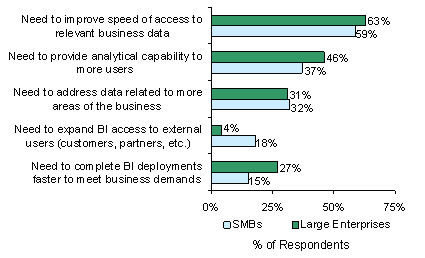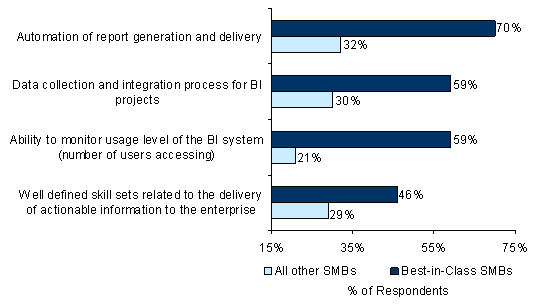BI for SMBs, Part 1: Deployment Strategies
How do the most efficient and effective companies leverage their BI solutions?
by Michael Lock and David Hatch
Given the growth in data volume and complexity inherent in today’s business landscape, particularly in light of the increased number of users, the challenges to effectively deploying business intelligence (BI) capabilities in an enterprise are becoming increasingly acute. These challenges, however, are not limited to large enterprises. Small and mid-size businesses (SMBs, defined as having less than $500 million in annual revenue) face a similar data crunch with the added difficulty of limited financial and human resources.
Companies of all sizes are beginning to investigate emerging deployment strategies to increase BI implementation effectiveness and improve access to BI capabilities across all levels of the organization. In addition to traditional on-premise client/server implementations, companies are exploring new deployment options, including:
- On-premise, Web-based deployment
- Multi-tenant hosted BI referred to as "software as a service" (SaaS) or "on-demand BI"
- Dedicated hosted BI or application service provider (ASP) BI
- BI appliances -- packaged hardware and software, or virtual machine software
- BI embedded within enterprise applications such as ERP, CRM, and BPM
IT and business management executives are asking critical questions to determine the best method for BI deployment: Which approach is the best for my organization? Does any one deployment method stand-out as a clear leader for solving the business pressures driving BI deployment costs today? What are the advantages and disadvantages of each approach?
Business Context
The pace of business has been increasing, and the advent of "data-driven decisions" in the 1980s and 1990s has now become a must-have in today's competitive business environment. As these capabilities permeated the enterprise, the need for faster decisions based on more robust information has worked its way down-market to the SMB realm.

Figure 1 - Top Five Business Pressures Driving
Optimization of BI Deployment
Source: Aberdeen Group, October 2008
Aberdeen’s research has found that SMBs and large enterprises (defined as those with more than $500 million in annual revenue) are aligned in their belief that the speed at which relevant business information can be accessed is the top business pressure driving a focus on BI deployment methods (see Figure 1).
The Value of Organizational Maturity
Much like at the enterprise level, BI deployments in smaller organizations cannot be treated as “plug-and-play” solutions. A successful deployment is heavily influenced by the tactical capabilities of the organization. Aberdeen’s analysis of the Best-in-Class SMBs demonstrates that successful deployments depend on a combination of specific capabilities at three important milestones of any BI project:
- Data collection: The process of identifying the data sources required to meet end users' information requirements, and the integration of the data sets (often in disparate formats) into logical models or databases for use within analytical applications and reporting tools.
- Application assembly: The ability to apply business rules to the integrated data resulting from the "data collection" phase. This can be performed physically with the data itself, or conceptually through the use of data modeling technology. The end result will be a construct that allows end-users to ask questions of the data and produce reports, graphs, and other analytical views.
- Information delivery. The ability to provide access to end users with a set of interfaces and delivery vehicles (Internet, e-mail alerts, reports, etc.) appropriate for each type of user. Optimally, the delivery of information will occur within a "self-service" environment where non-technical business users are capable of accessing information relevant to their roles without needing IT department intervention.
In support of each of the phases we listed, Aberdeen's research has identified several specific capabilities that top-performing SMBs are using at a far greater rate than all other SMBs to achieve their BI deployment performance goals (see Figure 2).

Figure 2 - Best-in-Class SMBs Leverage
Key Organizational Capabilities
Source: Aberdeen Group, October 2008
SMBs Drive Measurable Performance Improvements
Utilizing several internal capabilities in the areas of process, organization, knowledge management, and performance measurement, Best-in-Class SMBs were able to achieve tangible improvements across several key performance indicators. Aberdeen used the following three key performance criteria to distinguish Best-in-Class SMBs from Industry Average and Laggard SMBs:
- Self-service capability for non-technical business users of BI applications. All (100%) of Best-in-Class SMBs have achieved self-service BI capabilities for non-technical end users compared to 60% of Industry Average companies and only 18% of Laggard SMBs.
- Average time-to-completion of BI projects. Best-in-Class SMBs complete BI projects in an average of 71 days versus 94 days for Industry Average SMBs and 155 days for Laggards.
- End-user satisfaction with current BI capabilities. Seventy-six percent of Best-in-Class SMBs report that end users are at least “mostly satisfied” with current BI capabilities, compared with only 58% of users at Industry Average companies and only 40% of users at Laggard SMBs.
The top-performing SMBs are the ones that have taken a programmatic approach to BI deployment that keeps a close eye on the three stages of deployment: collection, assembly, and delivery of key enterprise information for the purpose of better decision making. By leveraging several internal capabilities and utilizing the deployment strategy most appropriate to their organizations, Best-in-Class SMBs are able to deliver analytical capability to more non-technical end users and do so in a dramatically reduced timeframe.
Editor's Note: You can access the report at http://aberdeen.com/summary/report/benchmark/5463-RA-business-intelligence-smb.asp. A short registration is required.
Michael Lock is a senior research associate in the technology markets group of Aberdeen Group. You can reach him at [email protected]. David Hatch is vice president and principal analyst at Aberdeen Group; you can contact him at [email protected].